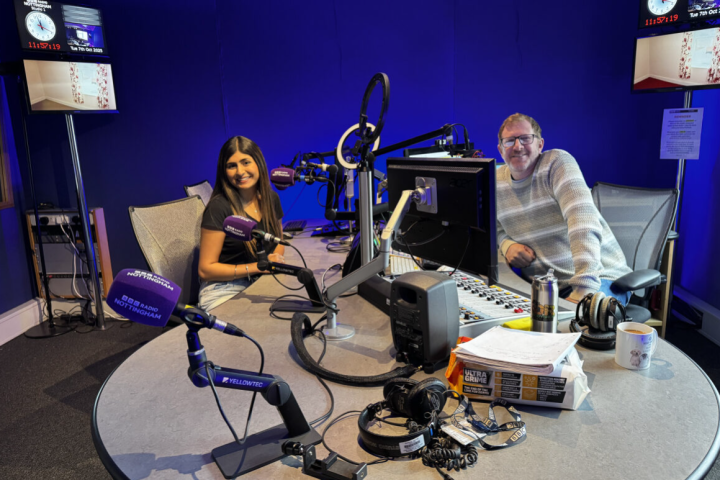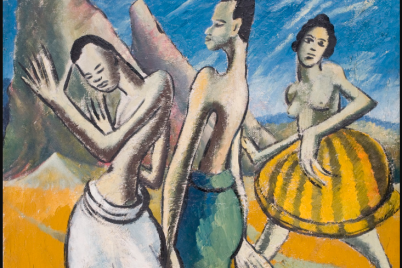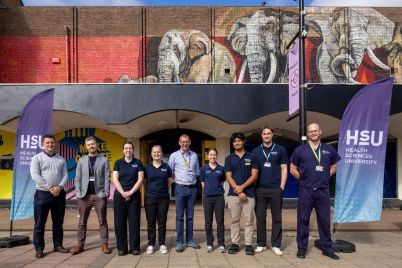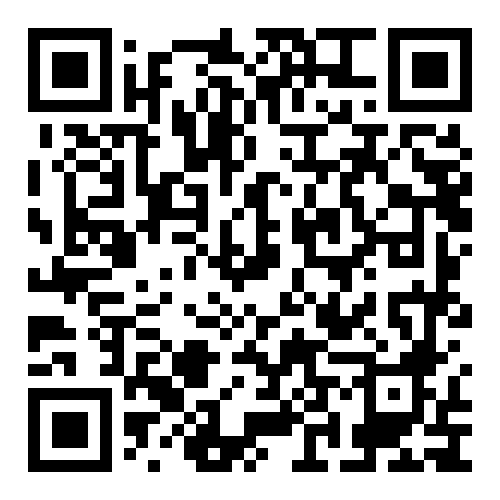As the nights draw in and Halloween celebrations light up campuses across the country, it’s the perfect time to think about personal safety — not just for one night, but all year round. Whether you’re heading out to a party, walking home from the library, or exploring a new city, staying aware and connected can make all the difference.
That’s where the Student Safety App comes in — a new tool designed by students, for students, to help everyone feel safer on and off campus. The app gives users real-time alerts about nearby incidents, offers features like “Track Me” location sharing and a “Fake Call” escape option, and connects directly with university and accommodation safety teams. Most importantly, it’s built on community — the idea that by looking out for each other, we can all help make student life safer.
To learn more about how it works, we spoke with Monica Ghuman, the app’s creator, about the inspiration behind it, the challenges of changing safety habits, and the difference it’s already making for students across the UK.
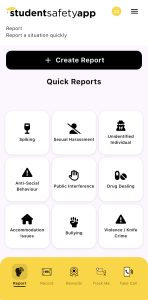
Screenshot
MG: To start off — if someone asked, “What is the Student Safety App?” how would you describe it?
Monica: I’d describe the Student Safety App as a kind of personal safety toolbox — a resource designed specifically for students, both on and off campus. It’s something you can rely on at any time of day, wherever you are. The main idea is to give students a real-time view of what’s happening around them, so they can stay alert and make informed decisions. Its core feature is incident reporting — students can see alerts about nearby incidents as they happen — but it’s also much more than that. It brings together everyone involved in the student experience: the university, accommodation providers, local services, and of course, students themselves.
MG: You mentioned real-time alerts — how exactly does that work?
Monica: When a student reports an incident through the app, that information goes straight to our control room. Within about ten minutes, our team verifies the report and sends out alerts to other students in the area. So, if something concerning is happening — whether it’s a safety issue, a suspicious situation, or a hazard — everyone nearby can be made aware instantly. Traditionally, students might only hear about something serious days later, through social media or the news. We wanted to change that delay and make sure students can actually act in the moment to stay safe.
MG: Who’s responsible for reporting those incidents?
Monica: It’s entirely crowd-sourced, meaning students report things themselves. The app relies on the community — it’s built on the idea that we all look out for one another. The more people use it, the more effective it becomes. We encourage students to report anything they see or experience that could impact safety — it’s quick, it’s anonymous, and it can genuinely make a difference for someone else nearby.
MG: And how does the app know where an incident has taken place?
Monica: When students download the app, they can give permission for it to access their location. That means when they submit a report, it automatically includes a pin on the map showing where it happened. It’s precise but secure — location data is only used for that moment and only to ensure the alert reaches people nearby.
MG: What kind of incidents can be reported?
Monica: We’ve built ten different reporting categories to cover a wide range of situations. These include things like suspected spiking, harassment, environmental hazards, and theft. The idea is to cover not just physical safety but also wellbeing — for example, unsafe environments or anti-social behaviour. Students can select a category and then add a short description to help the control room understand what’s happening.
MG: What inspired you to create this app in the first place?
Monica: It really came from my own experience at university. I remember how unsettling it was to hear about incidents long after they’d happened — especially tragic ones like the 2023 Nottingham attacks, where students Grace Kumar and Barnaby Webber were killed. Those events really stuck with me. I kept thinking: if students had access to something like this — a live alert system — maybe more people could have been warned or protected. That idea, of giving students real-time awareness and control over their own safety, is what drove me to develop the app.
MG: How have people responded to it so far?
Monica: The response from students has been amazing. They love how practical it is — especially the Fake Call feature, which lets them schedule a call to appear on their phone if they ever need an excuse to leave an uncomfortable situation. It’s a simple feature, but it’s one of the most popular because it’s something everyone can relate to. Universities have shown a lot of interest too, although their procurement processes can be lengthy. Student accommodation providers have been especially enthusiastic, because they see it as a way to keep their residents safe and build trust.
MG: What’s been the biggest challenge so far?
Monica: The hardest part has been encouraging students to make reporting a habit. This kind of app is brand new — there’s nothing else quite like it — so it takes time for people to get used to using it naturally. Students are great at adapting to technology, but reporting safety issues isn’t always instinctive. Once they see how easy it is and how much it helps others, though, engagement really grows.
MG: And what’s been the most rewarding part of developing it?
Monica: For me, it’s definitely been the connection with students. I’ve only recently graduated myself, so when I speak to students at Freshers’ events, I can talk about real experiences — nights out, walking home late, the kinds of things every student deals with. Seeing them respond with enthusiasm, knowing that something I’ve created could make them feel safer — that’s incredibly fulfilling.
MG: Tell me more about the control room you mentioned earlier.
Monica: Every report that comes through the app is reviewed by our 24/7 control room team. We have trained staff on duty at all times who are familiar with the platform and with safety protocols. When a report arrives, they verify it, remove any personal or sensitive details to keep the user anonymous, and then issue alerts to students within the relevant area. It’s a nationwide system, so no matter where you are, it works in the same way.
MG: Where do you see the app going next?
Monica: We’re already working on a version for colleges. It’ll use the same basic platform, but with different safeguards in place since college students are minors. We’re partnering directly with colleges to handle permissions and parental involvement properly. It’s exciting — the same principles of safety and community, just adapted to a younger audience.
MG: Is there any cost for students?
Monica: For university students, no — the app is completely free. For the college version, we’re exploring a subscription model that would be covered by the institutions themselves, not the students. The goal is always accessibility: we don’t want cost to be a barrier to safety.
MG: Where have you seen the most uptake so far?
Monica: Leicester and Nottingham Trent University have both shown fantastic interest, especially after Freshers’ Week where we had stands and demonstrations. Students there were really engaged — they asked great questions and downloaded it right on the spot.
MG: Do you have specific goals for growth this year?
Monica: Yes, we’re aiming for around 10,000 active users by the end of the year. That’s a realistic goal based on our current campaigns, which focus on awareness, partnerships, and on-campus presence. The more students we reach, the stronger the network becomes.
MG: You mentioned marketing campaigns — what kind are you running?
Monica: We run themed campaigns each week, each one tackling a sensitive but important issue — things like drink spiking, sexual harassment, or drug use. These aren’t easy topics to talk about, but we believe they’re vital. We use social media, student events, and university partnerships to raise awareness and show exactly how the app can help in those scenarios. The idea is to start honest conversations and build a culture of care and vigilance.
MG: You’ve described the app as a “toolbox.” What other features are included?
Monica: There’s quite a few. One is Track Me, where a student can share their live location with chosen contacts — like friends, flatmates, or family — for a set period. It’s great for those late-night walks home.
Another is the SOS Button, which sends an emergency text with the student’s location to their pre-set contacts if they feel unsafe.
We also have a Secret Record feature that lets users discreetly capture photos or audio — useful if they ever need evidence for a report.
And finally, there’s a Helpline Directory, preloaded with university-specific support services, so students can access help instantly if they need it.
MG: Are you planning to add more features over time?
Monica: Absolutely. The app is designed to evolve with students’ needs. We’re constantly gathering feedback from users to see what would make the biggest difference for them. For example, we’re exploring partnerships with local safety organisations and charities to expand the range of in-app support. Continuous improvement is a huge part of our philosophy.
MG: Have you partnered with local venues like nightclubs or student bars?
Monica: Yes, that’s something we’re actively doing. We’ve had really positive conversations with nightclubs and student venues. We’re not here to criticise or hurt anyone’s reputation — quite the opposite. We want to complement existing safety measures and show that we can all work together to make student nights safer and more enjoyable.
MG: And how do you ensure users’ data stays private?
Monica: Data security is absolutely central. Everything uploaded through the app is encrypted and stored locally for up to 30 days — we don’t keep it on our own servers. Any personal data is stripped before alerts are shared, so no report ever includes identifiable information. Students can report with complete confidence that their privacy is protected.
MG: Finally, what would you say to students who think it might be too much effort to use, or that they’ll never need it?
Monica: I’d say that’s understandable — no one wants to imagine themselves in a dangerous or uncomfortable situation. But the truth is, things can happen when you least expect it. Having this app isn’t about living in fear — it’s about being prepared, informed, and empowered. Even if you never need to use it yourself, you might use it to help someone else. That’s what community safety is all about.
MG: And just to confirm — it’s available on both iOS and Android?
Monica: Yes, it’s available now on both the App Store and Google Play. Anyone can download it and start using it straight away.

